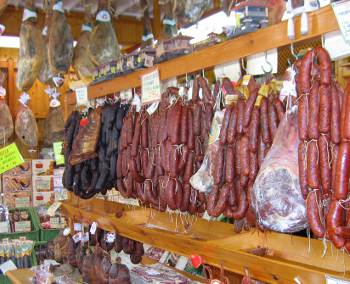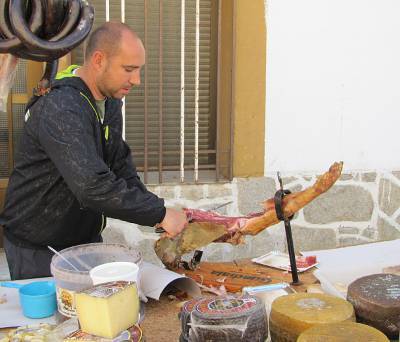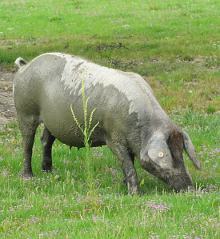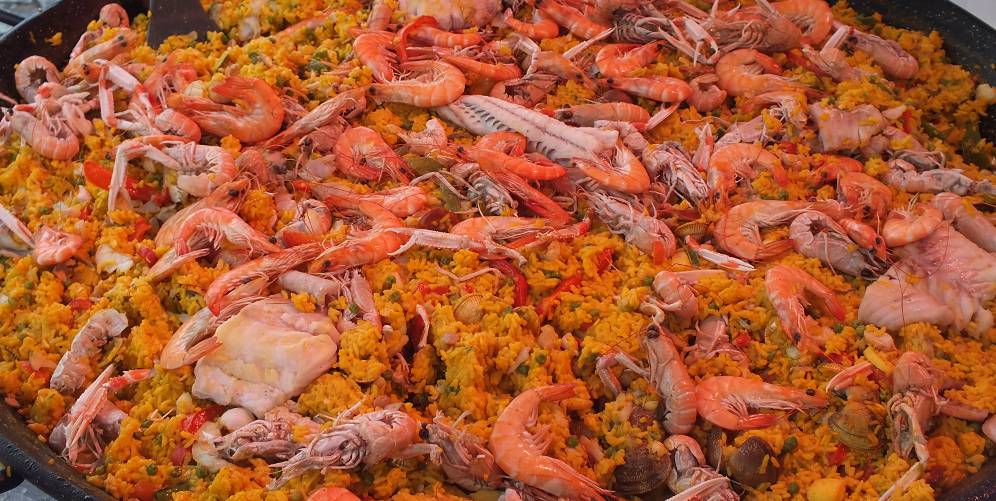About-Spain.net
- the alternative guide to Spain
| Subject Index: | The
Spanish way of eating |
Tapas |
| Restaurants |
Spanish
specialities |
Understand the menu |
Eating
in Spain - Spanish food, cooking and restaurants
Best rates on
hotels in Spanish cities
Booking.com offers
unbeatable online rates for hotels. Check out the following
areas :

Madrid

Toledo
Sevilla
Barcelona
Bilbao
Caceres
Other areas
About-Spain.net is
partnered with Europe's leading hotel booking portal, Booking.com, to
bring you the best online prices

Hams and chorizos in a Spanish delicatessen
For those whose aim in Spain is to eat in fast-food outlets or city snackeries, the daily timetable of Spanish life is irrelevant; but for others it is not. For any other purpose than lying on a beach, being in Spain means adapting to Spanish ways when it comes to organising your day; when in Spain.....
The Spanish day tends to start late, compared to other parts of Europe – which is normally no big problem for tourists. Hotels and cafés may not start serving breakfast - el desayuno - before 8 a.m, or even 8.30; and the process is often a leisurely one, since many people in Spain do not start work until 9 a.m. or even 10 a.m.
Spanish lunchtime, on the other hand, takes more getting used to. The "morning" in Spain runs on until 1.30 p.m or often 2 p.m., and it is only then that restaurants start opening up for lunch, which can generally be eaten until around 4 p.m. After that, it is siesta time, until things start opening up for business again; depending on the place, afternoon shop-opening in Spain may start from 4.p.m onwards, but in some places shops will not open until 6 p.m - for a four-hour afternoon opening time. Consequently, it is rare in Spain to find restaurants opening up for dinner service before 8 p.m, and in many parts 8.30 or 9 p.m are the normal opening times for dinner.
Tapas
Spanish restaurant opening times may go some way to explaining the Spanish habit of "tapas" - which are basically nibbles that people take either while they wait for lunch time or dinner time to begin, or else take instead of a more formal sit-down lunch or dinner. A lot of Spanish restaurants are attached to café-bars, and tapas are served in the café - bar area, more formal meals in a room behind or upstairs or next-door.Tapas - or slightly larger portions of the same known as raciones - are ordered at the bar, and usually eaten with a beer or a glass of wine or some other beverage. Usually they are displayed in serving containers on the counter or behind it, so are easy to order even if you don't know hat they are called. Popular tapas include olives, mussels, Serrano ham or even Iberico ham, chorizo (Spanish sausage), small bean-based appetizers and a range of others depending on the region and the individual café-bar. A popular tapa from Extremadura to Aragon is Migas, which are croutons (or old bread), sometimes egged, and deep fried in olive oil with bits of chorizo.
Restaurants

Valencian
paella as a primero plato

Cutting jamon ibérico on a local market
Postres, desserts, are not a great Spanish speciality: the most common ones are flan (caramel cream), rice pudding, ice-cream or fruit.
In ordinary to reasonably good restaurants, in 2017 a "menu del dia" (set menu with some choice ) will normally cost from about 8 € in small rural restaurants, to 15 € in better city establishments. "Menus" normally include wine or water or even una caña (a glass of beer), bread, and often coffee too, and are available for lunch and in the evening. Quality varies massively from restaurant to restaurant, and for 10 € - a common price in 2017 - you may get anything from a very poor meal with little to recommend it, to a delicious mouth-watering spread. On account of Spain's current economic plight, many good restaurants have started offering cheap menus del dia, just to bring in some customers.
For more Spanish dishes, see understanding the menu in Spain
A selection of Spanish specialities
- Chorizo : Spanish sausage, eaten either hot or cold. Chorizos are usually spiced with paprika, and can be hot or mild – but always tasty
- Fabada : A slow cooked casserole from northern Spain, consisting of white beans with paprika, peppers, and bits of ham and pork
- Gazpacho : a cold soup from Andalucia, made with fresh uncooked tomatoes, peppers and cucumber.
- Jamon iberico : the world's most exquisite ham, with an almost sweet taste to it, made from free-range pigs that have been brought up on a diet of acorns. The other main form of cured ham is jamon serrano, or mountain ham.
- Bacalao : cod, a national favourite, but just one among many fish on menus in restaurants all over Spain
- Paella : originally a Valencian dish, a risotto of saffroned rice with prawns, shellfish, pieces of chicken and other meat, and diced peppers - cooked in olive oil.
- Pulpos or calamares : squid, eaten as a main course, used in tapas, or included in a paella.
- Tortillas : omelettes. These can be served as a primero plato, or often as tapas; a slice of warm tortilla de patatas or potato omelette is a nourishing and quite filling tapa.
Continue Discover more about
Spain with ....
► Moorish Spain - Roman Spain - Castles in Spain
Other pages of interest : Travel in Spain
► You may also like : Food and eating in France
► Moorish Spain - Roman Spain - Castles in Spain
Other pages of interest : Travel in Spain
► You may also like : Food and eating in France
Top
photo: Valencian paella

With much of the population living near the sea, Spaniards are very partial to fresh seafood

Jamon ibérico, or Iberian ham, is made exclusively from free-range Iberian pigs raised in large oak plantations.

With much of the population living near the sea, Spaniards are very partial to fresh seafood

Jamon ibérico, or Iberian ham, is made exclusively from free-range Iberian pigs raised in large oak plantations.
| ►► Spain - a thematic guide: |
| Spain - the country Essential information about Spain. |
| Driving
in Spain A guide to Spanish roads and driving rules, with plenty of tips; |
| Tourism
in Spain
Where to go and what to see |
| The coasts of spain |
| Top attractions in Spain |
| Andalucia |
| Eastern Andalucia |
| Western Andalucia |
| Asturias |
| Castile y Leon |
| Castile La Mancha |
| Extremadura |
| Valencia |
| Undiscovered Spain |
| Map of the Spanish regions |
| Accommodation
in Spain Where to stay, and the different options available |
| The
Spanish
way of life Spain is different; all you need to know about Spanish habits, including |
| Spanish food and eating |

